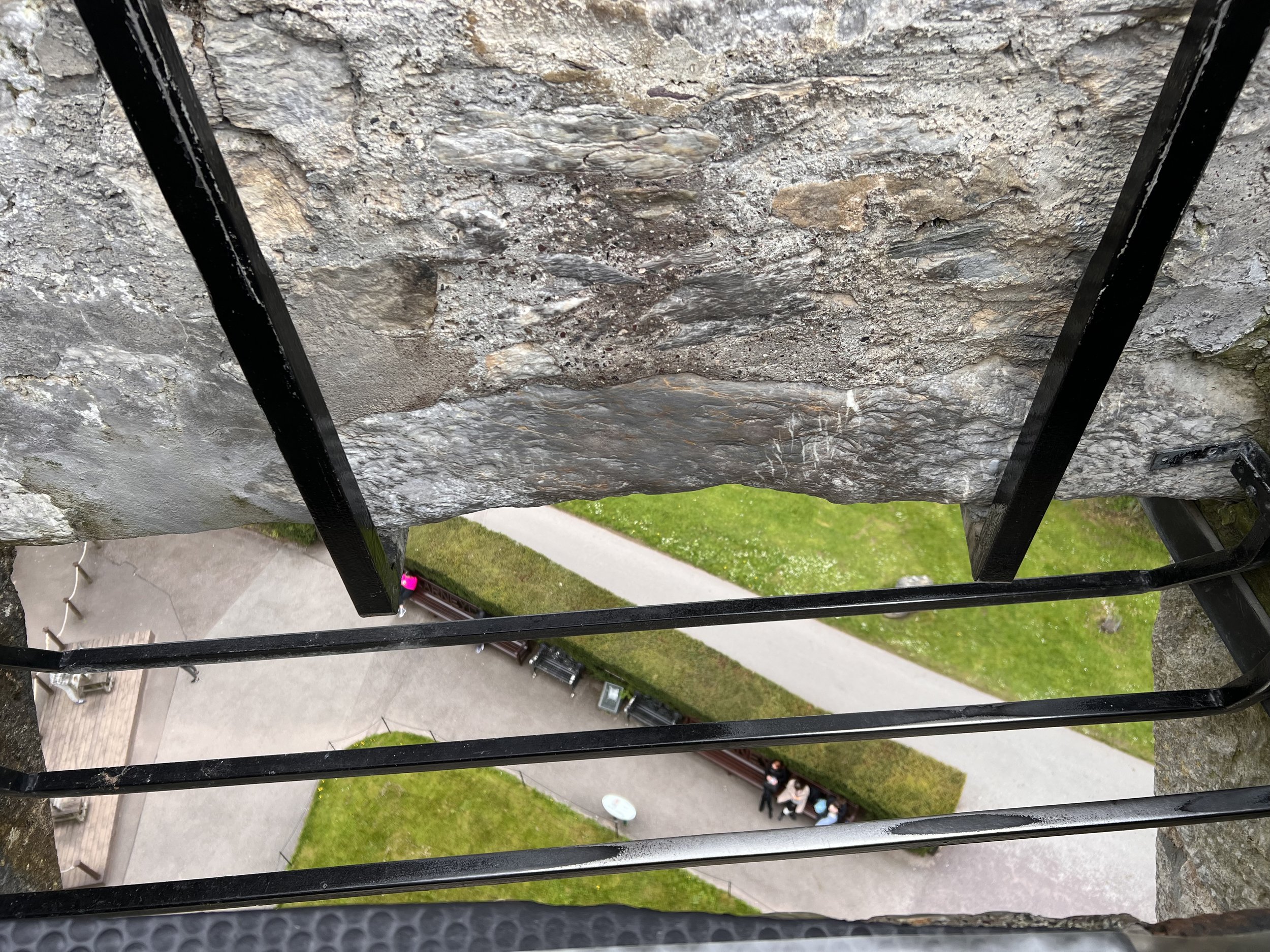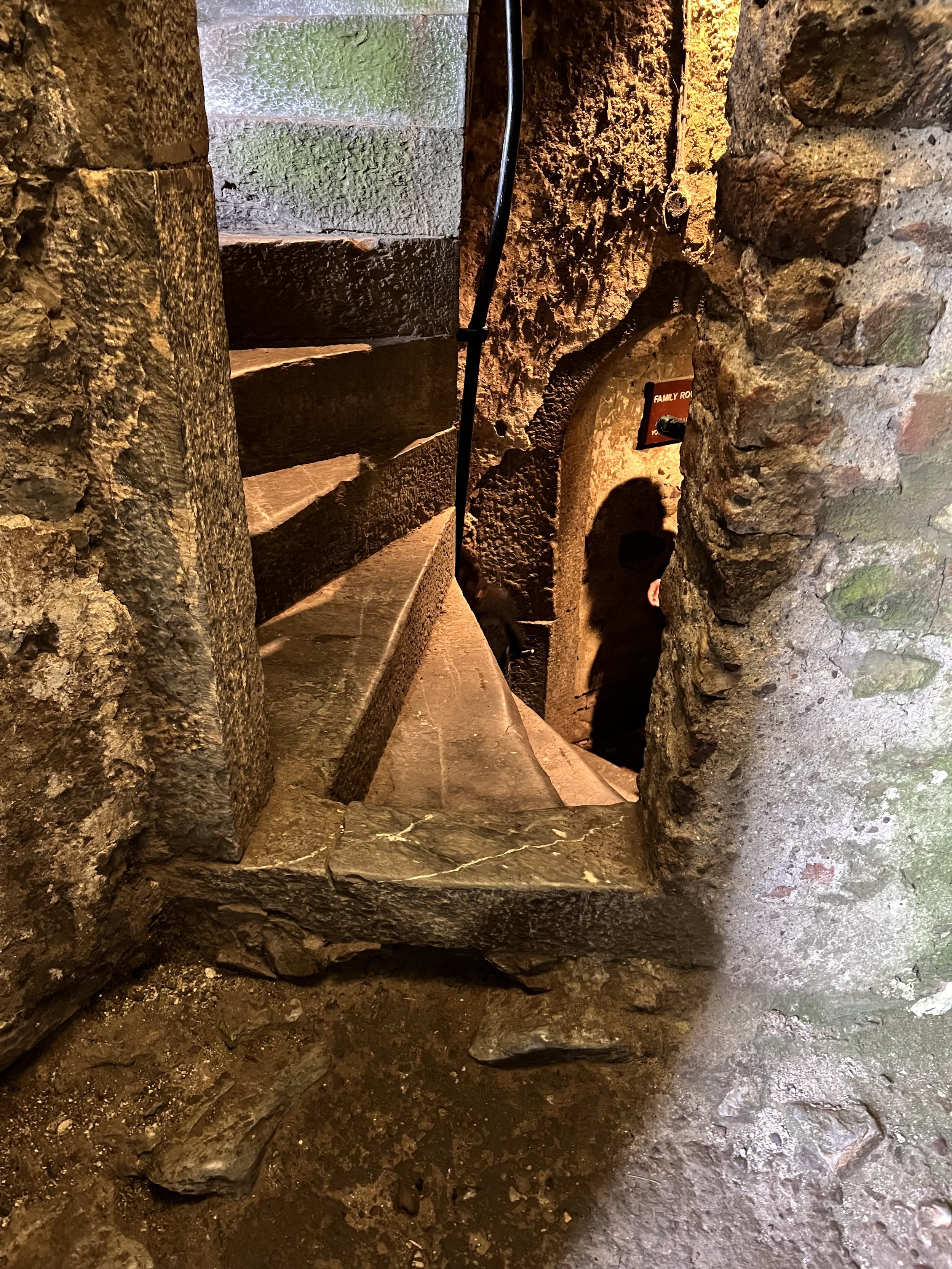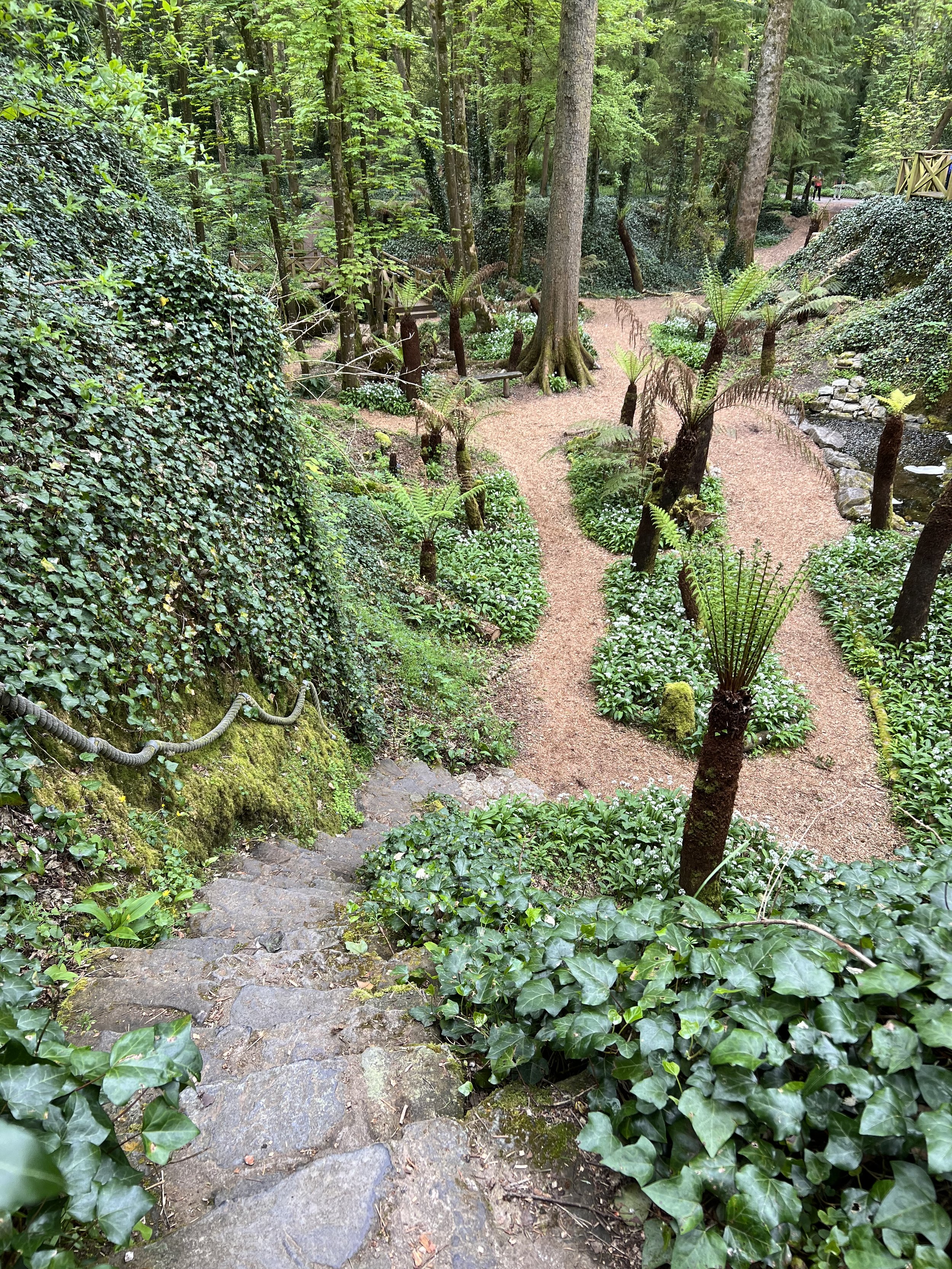Blarney Castle & Gardens
“I like this place, and willingly could waste my time in it.”
On Saturday morning (Apr 29) we said goodbye to the amazing Railroad Cottage and began our two-hour drive to Blarney Castle.
The road leaving our cottage…amazing.
Ignorance sometimes provides an opportunity to be surprised. This was certainly the case for us (and perhaps a spoiler alert 🚨 should you chose to continue reading). All we knew was there is this thing called the Blarney Stone and you kiss it.
Well we were in for an unexpected treat. From the moment we walked onto the grounds and glimpsed the castle, we were awestruck. The castle is impossibly romantic—rising majestically from its rocky perch, two rivers meandering beneath its walls, and exquisite gardens stretching in every direction.
In fact, I first titled this post “Blarney Stone” but changed it to “Blarney Castle and Gardens” because—with all deference to the famous stone—the castle, and especially the gardens, should receive at least equal billing.
Much like Ross Castle from the last post, Blarney Castle is not a castle but a tower house, a fortified medieval residence of stone. Blarney Castle was built by Cormac Laidir MacCarthy.
Every inch of this massive estate is thoughtfully and beautifully manicured.
Blarney Stone 101
If you’ve already kissed the Blarney Stone, you’re free to skip ahead 🤭. For those reading who, like us, knew absolutely nothing about the stone, here is some Blarney Stone 101.
The stone was set into the top of the tower in 1446 (look for the metal bars on the outside of the left wall).
You climb 127 steps to reach the top, and the old stone spiral stairwell gets quite narrow as you near the parapet walkway.
The extended battlement at the top of the tower includes several machicolations.
Extending the battlement beyond the castle walls, creates space for openings in the floor (machicolations), through which stones or other material, such as boiling water, hot sand, quicklime, or boiling cooking oil, could be dropped on attackers at the base of the defensive wall.
The Blarney Stone is the large rectangular stone at the bottom of the battlement wall (between the two vertical bars).
Back in the day, you kissed the outside surface of the stone by crawling over the top of the battlement wall, while two of your BFFs lowered you by your legs—all while trying not to focus on the perilous 85-foot drop to the ground below.
In the Sherlock Holmes radio dramatization "The Adventure of the Blarney Stone" (first broadcast on March 18, 1946), a man attempting to kiss the Blarney Stone falls to his death. Holmes' investigation reveals this as a murder, the man's boots having been surreptitiously greased before the attempt.
Thankfully, these days you kiss the inside surface of the Stone while lying on your back. Rather less thrilling I suspect, but probably the safer of the two options.
Amanda approaching the Stone—only one couple ahead of us! (Walking up to the castle we passed a “90 minutes” to the Blarney Stone sign, like at Disneyland. I can only imagine this place in summer!)
Rather than looking directly into the room below, you have to imagine a wooden roof that peaked above the arched window and slopped down on either side. Where I’m standing would have been the bottom of the roof.
Today, solid iron bars would prevent you from falling through the machicolation opening, but you still have to lie back farther than you think to reach the stone, and it is surprisingly unnerving.
😘
You just gotta hope that before your turn, Rocky Griswold didn’t kiss the stone with that lip fungus they ain't identified yet!
😘
Blarney
“There is a stone there, that whoever kisses, Oh! He never misses, to grow eloquent.”
The word blarney has come to mean "clever, flattering, or coaxing talk.”
Irish politician John O’Connor Power defined it this way: "Blarney is something more than mere flattery. It is flattery sweetened by humor and flavored by wit. Those who mix with Irish folk have many examples of it in their everyday experience." Today the word most associated with the kiss is gaining the gift of “eloquence.”
Why Kiss the Stone?
A number of stories attempt to explain the origin of the stone and surrounding legend.
It was said to have been the stone used by Jacob as a pillow when he dreamed of the ladder extending up to heaven with angels ascending and descending on it, and that it was brought from the Holy Land after the Crusades. 🤔
Cormac Laidir MacCarthy, the builder of Blarney Castle, being involved in a lawsuit in the 15th century, appealed to the goddess Clíodhna for her assistance. She told MacCarthy to kiss the first stone he found in the morning on his way to court, and he did so, with the result that he pleaded his case with great eloquence and won. Thus the Blarney Stone is said to impart "the ability to deceive without offending.” MacCarthy then incorporated the stone into the tower’s parapet. 🧐
A third legend was that the Blarney Stone was a piece of the Scottish Stone of Scone.
Since the Blarney Stone has been determined to be local limestone, it would appear the second myth is the only myth with possible merit. 🤨
On this diagram you can see the roof and the Blarney Stone (#8), plus the chapel, banqueting hall, and family room.
Standing opposite the Blarney Stone. As mentioned, imagine the peaked wooden roof over the rooms below. You also have to imagine two wooden floors, creating three rooms. The top room was the chapel (probably the original banqueting hall), the middle room was the banqueting hall (look for the fireplace on the left wall), and the bottom floor was the family room.
There is no denying the old stairs are amazing; no matter how many castles you visit, walking on the same steps that real people have been using at Blarney for roughly 577 years is a powerful experience.
The Watch Tower through an arrow slit window.
This house had some of the best examples of garderobes we’ve come across thus far. The two garderobes we toured had long passageways on the way to the actual place where you do your business.
This is because garderobes were also used to fumigate clothings, linens, etc. By allowing the wind to push ammonia up from the pit into the garderobe, the many minuscule bugs that lived in these items would be killed.
Garter means “to keep” and robe means “clothing.” Thus our modern word “wardrobe”—a place in which clothes may be hung or stored.
The bench is no longer here, but this was once a three-seater. Thank God for progress!
A large three-staller, perfect for shooting the shit. 😭
Because windows had no coverings, they often includes built-in drains to divert rainwater outside.
Floors were typically covered with reeds and threshing to make them softer and warmer. Stones at doorways were purposely raised to hold the thresh in the room—a threshold.
Passageway into a bedroom used by the chieftain’s three daughters.
The girl’s bedroom was on the bottom, and had a small fireplace (straight ahead). There was a wooden floor above, creating another room above accessible by the obvious door.
More amazing old stairs.
The “murder hole” over the front entrance. A large stone slab once covered the hole. It could be removed, which then left an opening through which an undesirable intruder could be attacked with deadly fire, boiling tar, or even a sword or pike!
Looking up at the murder hole. You have to love the blatant honesty in the name, not even a hint of euphemism.
This is the front door. The sign on the right describes how there was once an “oubliette,” a hidden 50-foot-deep pit with a conical roof you cannot climb out of. If your arrival was unwelcome, as you stepped on a certain paving stone, the guard could pull a lever on the wall. The stone would turn over and the ground would seem to swallow you up. Oubliette comes from the French to forget—and forgotten you would be.
A large window in the ground floor.
A very cool fireplace floating in the middle of the wall because the old wooden floor is now gone.
Tea Time
Irish Wolf Hound in wire mesh.
Tables in the Stables
Poison Garden
The property has a large poison garden that was so Harry Potter.
“Potter! What would I get if I added powdered root of asphodel to an infusion of wormwood?” -Professor Snape
Mandrake
“What is the difference, Potter, between monkshood and wolfsbane?" -Professor Snape
Professor Remus John Lupin
Narcissa Malfoy
This may be the craziest tree we’ve ever seen.
The Fern Garden is a uniquely interesting space.
While only just beginning to sprout their branches, this sunken garden was still amazing to explore, like you were suddenly on the Jurassic Park set and not Blarney Castle.
Explosions of color!
Blarney House
Situated in the middle of the property, just beyond the Castle is Blarney House.
The house was built in 1874 to welcome the return of the family after an absence of 54 years. Typical of High Victorian buildings, Blarney House incorporates elements of several other styles. Its porch is neoclassical and comes from the Colthurst’s house at Ardrum, a neighbouring estate.
Above the porch, the second story window is embellished with Jacobean strapwork.
The skyline is pure Scots baronial with stepped gables and a turret (rare in the southern half of Ireland). The skyline is wonderfully lively, with conical roofs to the towers surmounted by decorative finials, and tall chimneys galore.
The house was not open for tours on the day we visited.
Such as amazing tree!
Rock Close
Opposite the Main Gardens is this forested close, dense with plants and rocks and magical sights.
We were in the Fairy Forest section when some movement caught Amanda’s eye. She spotted this little guy wandering around doing whatever it is that mice do all day. Its funny how cute he is in this setting and not such much when he’s popping out of your kitchen drawer (true story)!
Such a lovely blue.
It takes little imagination to see who is imprisoned here. The Witch of Blarney has been with on the grounds since the dawn of time. Some say it was she who first told MacCarthy of the power of the Blarney Stone. Fortunately for visitors, she only escapes the witch stone after nightfall—and the property closes at dusk.
The Druid’s Cave is said to once be the home of a religious hermit who was fed and cared for by the Jefferyes family, and it may well have sheltered many others through the centuries.
Witches Kitchen—Historians will tell you that this was home to early Irish cave dwellers. But if you arrive early enough in the morning, you may still see the dying embers of a fire. Legend tells us that the Blarney Witch lights the fire every night as she fights to stop shivering after her nocturnal escape from the cursed witch's stone.
Wishing Steps—For hundreds of years, the Blarney Witch has taken firewood from the Estate for her kitchen. In return, she must grant visitors wishes.
It you can walk down and back up these steps with your eyes closed—some suggest walking backwards—and without for one moment thinking of anything other than a wish, then that wish will come true within a year.
By the way, the steps are wet and slippery.
Dolman—The secrets of this megalithic tomb portal are lost in the mists before history began. Was the great rock rolled or was it lifted? Why does it still sometimes rock? What magic and mysteries has it guarded over the millennia? We cross the portal with care—and we wonder…
Legend tells of a famous King of Munster who once ruled these lands. He had seven daughters and two sons. His rival was also a powerful clan chief and the time came when the king had to defend his lands.
One fateful day the army rode out to battle with the king and his two sons at the head. Although victorious it came at a great cost, as both sons were killed in the fighting.
The army marched back to the castle, on route passing the ancient druids stone circle that had stood for millennia. The king dispatched a contingent of men to the sacred site and in his grief he instructed them to push over two of the nine standing stones. This would forever commemorate his two fallen sons. The Seven Sisters remain.
These Three Yew Trees are known as "The Three Wise Men," which probably alludes to their longevity and that they are the oldest trees on the estate. All three Taxus baccata (Common Yew Tree) are in the region of 500-600 years old.
The Yew tree is one of the longest living trees with some surviving more than 2,000 years and they are in existence throughout Europe and as far east as Iran.
If one is struggling to locate Yew tree, then a visit to most Christian graveyards in Europe should present the visitor with many, where they are planted due to their lasting stature. One note of caution is that the leaves are highly toxic, especially when crushed or burned. Indeed the leaves are so toxic to animals that Yew trees are rarely found on farmland.
After over four hours of wandering the estate, we can safely say that Ireland really has something over England. We’ve visited a great many English estates with magnificent gardens, but the Blarney estate is the clear winner—largely due to the sheer variety on offer—a very romantic castle, two beautiful rivers, lake, poison garden, carnivorous garden, massive fern garden, Victorian mansion, lime kiln, ice house, horse graveyard, Himalayan Valley, Vietnamese Woodland, bee observatory, everything in the magical Rock Close, the Blarney Stone, dungeon—oh, and did we mention caves under the castle?!
Yep, a hidden cave under the castle. When Cromwell’s General, Lord Broghill, besieged the castle, he fired down from Card Hill above the lake and broke the tower walls. Yet when he entered the castle, he found only two trusty old retainers, The main garrison had fled through Badger’s Cave.
Come for the Stone, but leave yourself hours to explore the amazing castle and 60 acres of surprises, delights, and mysteries in the gardens. You will not be disappointed.



















































































